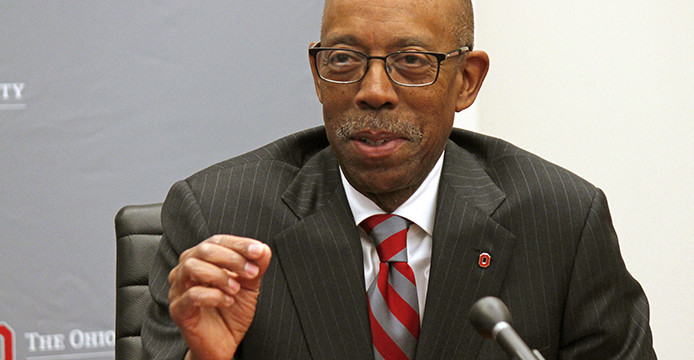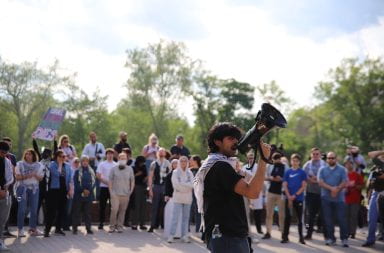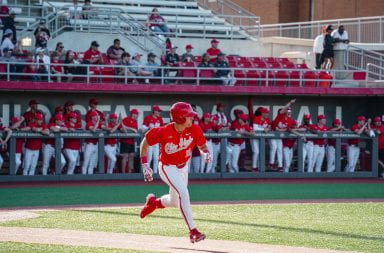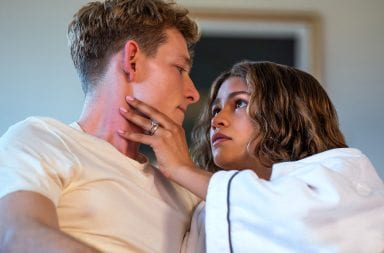
University of California Irvine Chancellor Dr. Michael Drake at a press conference Jan. 30. Drake is set to assume the OSU presidency June 30.
Credit: Ritika Shah / Asst. photo editor
A new leader doesn’t come cheap—Ohio State dished out nearly $610,000 in its efforts to find a president, ensuring along the way that the people conducting the search and the candidates they found ate and traveled well.
Over the course of a six month presidential search, OSU used “unrestricted funds” to pay a private search firm, a private business jet rental company and other various restaurants and businesses in the Columbus area, expenses that one OSU professor said don’t seem extreme.
And while that spending resulted in the hiring of a president that officials have said they’re enthusiastic to have, the man chosen doesn’t seem to have been those officials’ first choice.
Dr. Michael Drake, the current chancellor at University of California Irvine, will become OSU’s president June 30. His salary is set at $800,000 annually, with a deferred compensation credit of $200,000 each year and eligibility for an annual bonus of as much as $200,000.
Though OSU’s presidential search kept candidates a secret, a public records request revealed the names of at least a few other people considered for the job. The most notable was David Skorton, Cornell University’s president, who is moving on to a position at the Smithsonian Institute later this year.
Bill Funk, president of Dallas-based search firm R. William Funk & Associates, emailed Skorton Sept. 16, seeking to gauge Skorton’s level of interest in being considered for the OSU presidency.
“(OSU has) specifically requested that I contact you and see if there is any way you might have interest in that position,” the email read. “They assure me that they can make it worth your while financially … They obviously would find an appropriately meaningful and attractive position for your spouse.
“If you were to have an interest, the Board (of Trustees) would meet with you and forgo other candidate conversations pending your continuing interest.”
The email noted OSU officials were most interested in Skorton because of a medical background and a knowledge of health science centers given the OSU Wexner Medical Center expansion.
The records don’t show whether Skorton replied.
OSU signed a contract with R. William Funk & Associates Sept. 17 agreeing to pay the firm a fixed fee of $200,000 and reimburse it for direct, out-of-pocket expenses. The contract also included an additional cost of $20,000 to cover administrative and support expenses.
Monthly invoices from the firm, provided through a public records request, showed those expenses totaled $231,272. The out-of-pocket expenses included hiring several companies to do background research on candidates.
OSU spokesman Gary Lewis said no student or tax money was used to fund the presidential search, as the costs came from unrestricted funds. Unrestricted funds are given by a donor to an organization to be used as the organization sees fit.
The amount OSU spent was nearly two or three times what some other schools doled out this year for their presidential searches. University of Michigan spent about $320,000, according to an MLive article, while Kent State paid more than $211,000 in finding a new leader, according to the Record-Courier.
But Richard Dietrich, a member of the OSU Faculty Council and an accounting professor, said the amount OSU spent seems reasonable. He broke the parts of the search down into what he speculated would be a typical expense for each.
“A rule of thumb is that a search firm will be paid about 1/3rd of the leader’s first year compensation. So if President Drake will be paid $800,000 … the search firm might be paid up to $267,000,” he said in an email.
Allan Silverman, an OSU philosophy professor and a former faculty chair for University Senate, cited the same figure.
“The going rate (for a search firm) is generally a percentage of the salary paid to the incoming president, roughly 33 percent,” he said in an email.
According to the records, OSU also paid NetJets, a Columbus-based private business jet rental company, $186,714 for 10 flights, or five round trips, between Port Columbus International Airport and airports in Lincoln, Neb., Atlanta and Santa Ana, Calif., the latter of which is about a 16-minute drive from UC Irvine.
Dietrich’s breakdown made that figure seem like it was on the high end.
“Once candidates are identified, some members of the search firm and the search committee typically travel to one or more ‘neutral’ cities to conduct preliminary, face-to-face interviews,” he said. “These travel costs might be significant—perhaps $100,000 depending on the number of candidates interviewed in this initial round.
“Once finalists are selected, they sometimes are invited to Columbus … This also might include spouses or family members. The cost might be $20,000 or more depending on travel arrangements and the number of finalists traveling.”
The records also indicated that Cameron Mitchell Restaurants earned $8,440 from OSU during the search, including $764 when the search committee met Drake and $3,039 for a lunch for the search committee.
And about $95,630 was spent on advertisements in The New York Times, The Columbus Dispatch and The Chronicle of Higher Education for the Symposium on the University Presidency in August.
The symposium, a discussion held at the Ohio Union about what qualities a president should have and what a president should expect in his or her term, cost nearly $118,000 total, including travel, hotel rooms, transportation, advertising, dinner and honoraria, which are payments given for professional services on which there is no set price. The event featured four panelists from various higher education institutions and a moderator from the Harvard Graduate School of Education.
Dietrich said advertising costs especially are justified.
“Although OSU is internationally recognized, good candidates may not be aware of our presidential search. To assure that we can identify an outstanding, diverse group of candidates, there may be a substantial advertising program. This program might cost $100,000,” he said.
The approximately $65,470 remainder of the search expenditures went to companies and locations including Office Max, Target, UniPrint and the Longaberger Alumni House for things like printouts, refreshments and room rentals.


